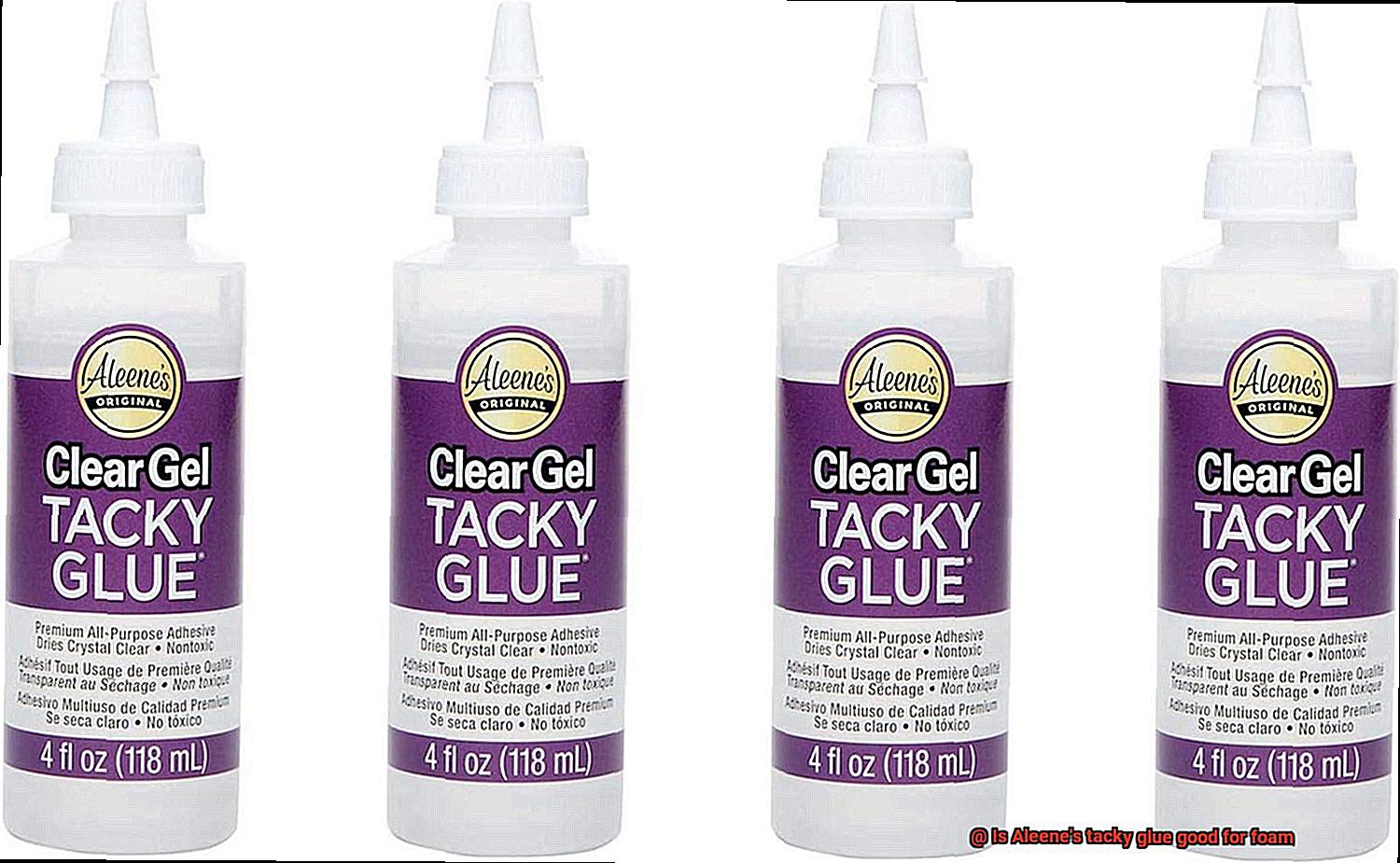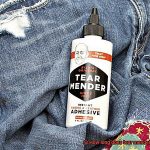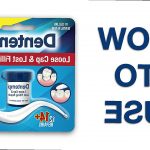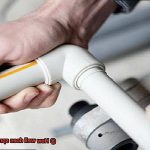Ready to dive into the world of foam crafting?
Contents
- 1 What is Aleene’s Tacky Glue?
- 2 Benefits of Aleene’s Tacky Glue for Foam Crafting
- 3 How to Apply Aleene’s Tacky Glue on Foam Projects
- 4 Advantages of Using Aleene’s Tacky Glue for Foam Projects
- 5 Disadvantages of Using Aleene’s Tacky Glue for Foam Projects
- 6 Tips and Tricks for Working with Aleene’s Tacky Glue on Foam Projects
- 7 Common Mistakes to Avoid When Using Aleene’s Tacky Glue on Foam Projects
- 8 Alternative Adhesives to Consider When Working with Foam Materials
- 9 Conclusion
Whether you’re a seasoned pro or just dipping your toes, finding the perfect adhesive is key. And that’s where Aleene’s Tacky Glue steps in, like a trusty sidekick ready to tackle any foam project.
This glue has made quite the name for itself in the crafting realm, known for its versatility and unwavering reliability. But does it really live up to the hype when it comes to foam?
Well, my friend, that’s what we’re here to find out. In this post, we’ll be delving deep into the world of Aleene’s Tacky Glue and its compatibility with foam.
So, if you’re itching to unleash your creativity with foam or simply want an adhesive that won’t let you down, stick around (pun intended) as we uncover whether Aleene’s Tacky Glue is truly a match made in crafty heaven for your foamy creations.
What is Aleene’s Tacky Glue?
Crafting is a beloved hobby that allows individuals to express their creativity and create unique projects. An essential tool in any crafter’s arsenal is a reliable adhesive, and Aleene’s Tacky Glue has been a trusted choice for over 50 years. In this article, we will explore the features and uses of Aleene’s Tacky Glue, highlighting its versatility and why it is favored by crafters worldwide.
Features and Benefits:
Aleene’s Tacky Glue stands out among other adhesives due to its tacky consistency. Unlike runny glues that can cause messes, the tackiness of this glue helps it adhere to surfaces without dripping or running.
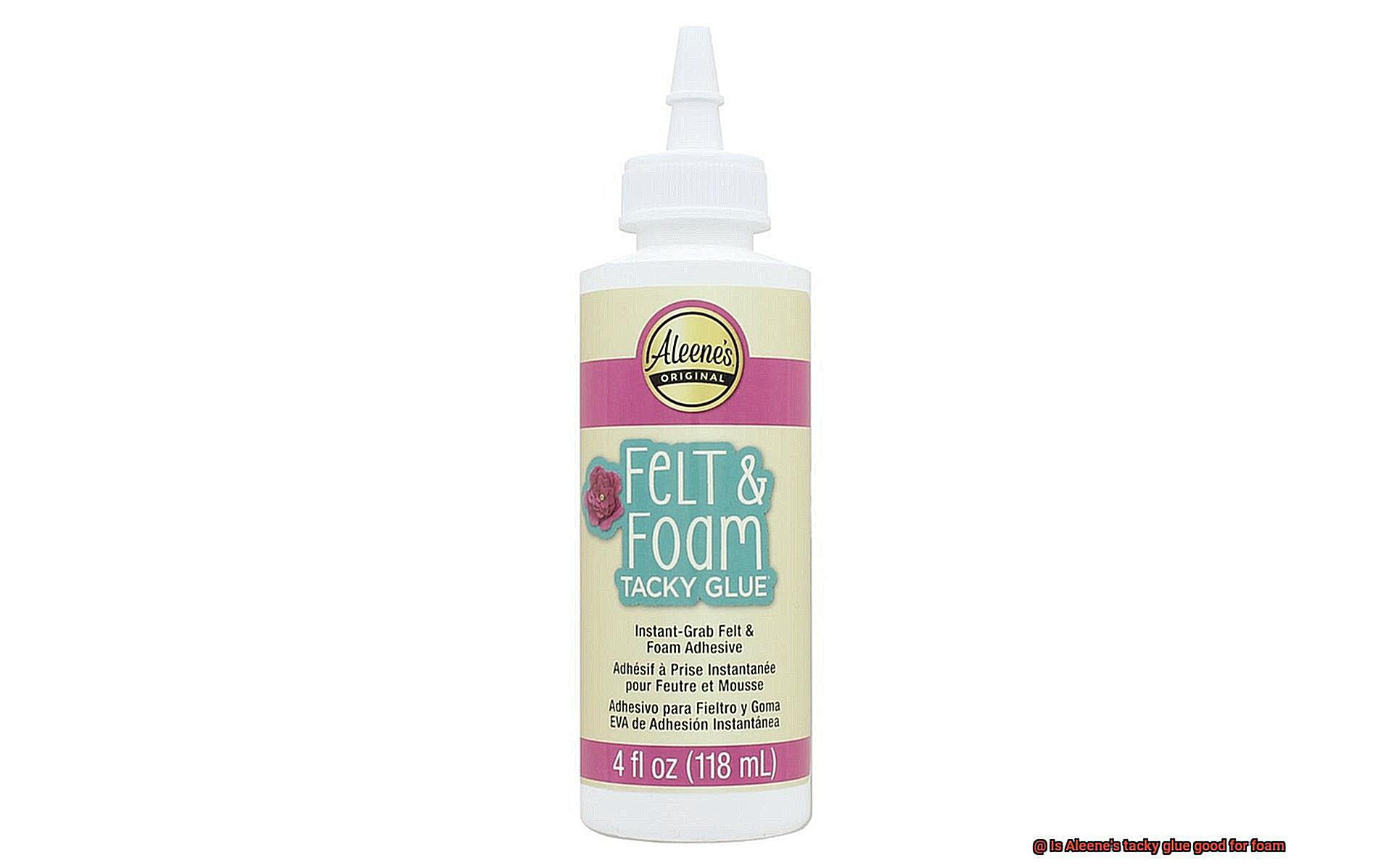
This feature gives crafters better control during application and ensures precise placement of the adhesive.
Another notable feature of Aleene’s Tacky Glue is its quick drying time. Within 15-30 minutes, depending on the thickness of the application, the glue sets and dries completely. This fast drying time allows crafters to continue working on their projects without extended waiting periods, enhancing productivity.
Versatility in Crafting:
While Aleene’s Tacky Glue is not specifically marketed as a foam adhesive, it has gained popularity among crafters for its effectiveness in bonding foam materials. Foam requires flexibility, and this adhesive provides just that.
Once dry, Aleene’s Tacky Glue remains flexible, enabling the bonded foam to bend and stretch without compromising the bond. It is suitable for various foam crafts, including attaching foam pieces together or securing foam to other surfaces like paper or fabric.
Furthermore, Aleene’s Tacky Glue is also compatible with a wide range of materials beyond foam. Whether working with wood, plastic, fabric, or other surfaces commonly used in crafting, this adhesive provides a strong and durable hold.
Safety and Ease of Use:
Crafting is a creative outlet enjoyed by people of all ages, and safety is paramount. Aleene’s Tacky Glue is non-toxic and water-based, making it safe for adults and children to use. Its easy application, thanks to the glue’s tacky consistency, allows for precise bonding without the need for additional tools or techniques.
Benefits of Aleene’s Tacky Glue for Foam Crafting
When it comes to foam crafting, Aleene’s Tacky Glue stands out as a game-changer. With its unrivaled bond strength, quick drying time, flexibility, safety, versatility, and affordability, this glue has become a staple in the crafting community.
Strong Bond:
Foam presents a challenge due to its lightweight and porous nature. However, Aleene’s Tacky Glue is specifically formulated to provide a secure and durable bond on various materials, including foam. Its thick consistency allows it to grip the surface of the foam, creating a bond that can endure regular handling and movement.
Quick Drying Time:
Waiting for glue to dry can be frustrating, especially when inspiration strikes. Fortunately, Aleene’s Tacky Glue sets within minutes, enabling you to continue working on your project without delays. Say goodbye to idle thumbs and hello to uninterrupted creativity.
Flexibility:
Foam is known for its ability to bend and stretch, making it essential to use a flexible glue that won’t cause cracks or breakages. Aleene’s Tacky Glue maintains its flexibility even after drying, ensuring that your foam crafting projects remain intact and can withstand any movements or manipulations.
Safety First:
Crafting should be a safe and enjoyable activity for all ages. Aleene’s Tacky Glue is non-toxic and safe to use, eliminating worries about harmful fumes or health risks. Unleash your creativity with peace of mind.
Versatility:
Whether you’re working with EVA foam, craft foam, or foam sheets, Aleene’s Tacky Glue is your go-to adhesive. It effectively bonds different pieces of foam together, allowing you to create costumes, props, decorations, and more with ease. The possibilities are endless.
Affordability:
Crafting shouldn’t break the bank, and neither should your adhesive. Aleene’s Tacky Glue is readily available and reasonably priced compared to other options on the market. Regardless of your crafting experience, this glue offers excellent value for money.
How to Apply Aleene’s Tacky Glue on Foam Projects
Crafting with foam requires a strong adhesive, and Aleene’s Tacky Glue is a popular choice. This guide will walk you through the step-by-step process of applying Aleene’s Tacky Glue on foam projects, ensuring a secure and long-lasting bond. Let’s dive in.
Step 1: Prepare the Foam Surface
Before applying the glue, ensure the foam surface is clean and free from dust or debris. Gently wipe the foam with a clean cloth or use a soft brush to remove any loose particles. This step guarantees a smooth and secure bond.
Step 2: Apply the Glue
Now it’s time to apply Aleene’s Tacky Glue. Squeeze a small amount onto the desired area of your foam project. Remember, a little goes a long way. To spread the glue evenly, use a small brush or toothpick. Make sure to cover the entire area that needs to be bonded. Be careful not to apply too much pressure, as this can distort the foam.
Step 3: Press and Hold
Once the glue is applied, press the foam pieces together firmly. Hold them in place for a few seconds to allow the adhesive to bond. For larger or heavier foam pieces, consider using clamps or weights to ensure a strong and secure bond.
Step 4: Let it Dry
Patience is key – allow the glue to dry completely. Drying time may vary based on factors like humidity and temperature, so refer to the instructions on the glue bottle for specific drying times. Avoid moving or disturbing the foam project until the glue has fully dried.
Step 5: Clean up Any Spills
Oops. Accidentally spilled some glue? No worries. Clean it up immediately with a damp cloth or sponge. Aleene’s Tacky Glue is water-soluble when wet, making it easy to remove. However, once the glue dries, it forms a strong bond that is difficult to remove.
Step 6: Test and Enjoy
Before starting a big foam project, it’s always a good idea to test the glue on a small, inconspicuous area first. This ensures compatibility and avoids any unwanted damage. Once you’ve completed the process, sit back and enjoy your securely bonded foam project.
Advantages of Using Aleene’s Tacky Glue for Foam Projects
This incredible adhesive has a plethora of advantages that make it the perfect choice for all your foam creations.
First and foremost, Aleene’s Tacky Glue boasts a thick consistency that ensures a strong bond with foam surfaces. Unlike other glues that may seep into the foam or cause warping, Aleene’s Tacky Glue adheres firmly without compromising the integrity of your foam masterpiece.
Speaking of bonds, this glue creates a durable and long-lasting connection between foam pieces. Once applied, Aleene’s Tacky Glue dries clear and holds the foam together securely. Say goodbye to worries about your projects falling apart.
But its advantages don’t stop there. Aleene’s Tacky Glue is not just perfect for craft foam, but it can also be used on upholstery foam and even foam rubber. Its versatility knows no bounds, making it an indispensable adhesive for all your foam crafting needs.
And let’s not forget about its quick drying time. Gone are the days of waiting hours or even days for your glue to set. Aleene’s Tacky Glue sets relatively fast, allowing you to continue working on your project without any unnecessary delays.
Safety is always a top priority, especially when working with children or if you have concerns about harmful chemicals. Luckily, Aleene’s Tacky Glue is non-toxic and safe for use on foam. Craft with peace of mind knowing that this water-based glue doesn’t emit any strong odors or fumes.
Now let’s talk about affordability. Aleene’s Tacky Glue is not only high-quality but also budget-friendly. It won’t break the bank, and you can easily find it at most craft stores or online retailers. Crafting on a budget has never been easier.
Last but certainly not least, using Aleene’s Tacky Glue for foam projects is a breeze. The squeeze bottle with a precision tip allows for controlled and precise application of the glue. Plus, the consistency of the glue makes it easy to spread and work with, ensuring neat and professional-looking results on your foam projects.
Disadvantages of Using Aleene’s Tacky Glue for Foam Projects
Foam projects offer endless possibilities for creativity and craftsmanship, but choosing the right adhesive is crucial for ensuring a successful outcome. While Aleene’s Tacky Glue is a popular choice, it does come with its fair share of disadvantages when used on foam. Let’s explore these drawbacks in more detail.
Firstly, drying time becomes a major hurdle when using Aleene’s Tacky Glue for foam projects. Foam is naturally porous, allowing the glue to penetrate its tiny air pockets. Unfortunately, this means that the glue takes longer to dry completely, resulting in frustratingly extended waiting times before you can move or handle your foam creation. This can be particularly problematic if you have a time-sensitive project or a looming deadline.
Another drawback is the stiffness of the bond created by Aleene’s Tacky Glue. Foam is renowned for its flexibility, which is often required even after gluing. Unfortunately, this adhesive creates a rigid and inflexible bond that restricts the natural movement of foam. This makes it less suitable for projects that demand some degree of flexibility, such as costumes or cushions.
Furthermore, Aleene’s Tacky Glue has the potential to warp or distort foam. The chemical composition of the glue can react with the foam, causing unexpected shrinkage or changes in shape. This can be disastrous for intricate or delicate foam designs, as the glue may alter their intended dimensions or overall appearance.
Moreover, Aleene’s Tacky Glue may not provide a strong enough bond for certain foam projects. Foam is lightweight by nature, and depending on the weight or stress applied to glued joints, the bond created by this adhesive may not be sufficient. Over time or under strain, the foam pieces may come apart, compromising the integrity of your carefully crafted project.
Additionally, Aleene’s Tacky Glue lacks waterproofing properties. Foam projects are susceptible to moisture exposure or require occasional cleaning. Unfortunately, if the glued foam gets wet, the glue may weaken or dissolve, resulting in a loss of adhesion and potential damage to your beloved creation.
Lastly, it’s worth mentioning that Aleene’s Tacky Glue has a distinctive odor that some individuals may find unpleasant or irritating. This can pose a significant concern, especially for those who are sensitive to strong smells or have respiratory issues. Working on a foam project in an enclosed space can become an uncomfortable or even hazardous experience.
Tips and Tricks for Working with Aleene’s Tacky Glue on Foam Projects
Its strong bond and versatility make it perfect for a wide range of foam projects. In this article, we will explore some valuable tips and tricks to help you achieve the best results when using Aleene’s Tacky Glue on your foam crafts.
Prepare the Foam Surface:
To ensure a strong adhesive bond, it is crucial to start with a clean foam surface. Use a damp cloth or a soft brush to remove any dust or debris. For better adhesion, lightly roughen the foam surface with sandpaper or a nail file. This creates more texture for the glue to grip onto.
Apply Thin Layers:
Instead of applying thick globs of glue, opt for thin layers. This prevents the glue from seeping through the foam and causing unwanted marks or stains. Additionally, thin layers dry faster, allowing you to continue working on your project without delay.
Let it Dry:
After applying the glue, give it a few minutes to dry and become tacky before pressing the foam pieces together. This tackiness creates a stronger bond when the pieces are joined. Press the foam firmly together, applying even pressure, to ensure a tight and secure hold.
Make Adjustments while Wet:
If you need to reposition or adjust the foam pieces after gluing, do so while the glue is still wet. Once it dries, making changes becomes challenging without potentially damaging the foam. Work quickly and make any necessary adjustments before the glue fully sets.
Clean Up with Water:
Aleene’s Tacky Glue is water-based, making cleanup a breeze. If you have any spills or excess glue, simply dampen a cloth or sponge with water and gently wipe away the glue before it dries. This keeps your workspace neat and ensures a professional finish.
Common Mistakes to Avoid When Using Aleene’s Tacky Glue on Foam Projects
Foam projects offer endless possibilities for creativity, and Aleene’s Tacky Glue is a popular adhesive choice for securing foam pieces together. However, to achieve the best results, it’s important to be aware of the common mistakes that can occur when using this glue on foam projects. By avoiding these pitfalls, crafters can ensure a successful and long-lasting bond.
One mistake to avoid is using too much glue. While it may be tempting to apply a generous amount of adhesive, a little goes a long way with Aleene’s Tacky Glue. Using an excess amount can cause the glue to seep through the foam, leaving behind unsightly stains. Additionally, an excessive amount of glue takes longer to dry, resulting in a messy and uneven bond. To prevent this, apply the glue sparingly and evenly across the foam surface.
Another mistake to avoid is not allowing enough drying time. Aleene’s Tacky Glue requires adequate drying time to achieve a strong and secure bond. Rushing the drying process can lead to the foam pieces not adhering properly, increasing the risk of project failure. It’s crucial to follow the manufacturer’s instructions regarding drying time and ensure that the glue is completely dry before handling or moving the foam.
Using Aleene’s Tacky Glue on porous foam surfaces is also a common mistake. This type of glue is specifically designed for non-porous materials and may not provide a strong bond on porous foam surfaces. Testing a small area before applying the glue to the entire project is recommended. If the glue does not adhere well or seeps into the foam, it may be necessary to consider using a different adhesive specifically formulated for porous materials.
Not applying the glue evenly and consistently across the foam surface is another mistake that can compromise the overall quality of the project. Uneven application can result in weak spots or areas where the glue doesn’t bond properly, compromising the structural integrity of the foam project. To ensure a strong and secure bond, spread the glue evenly using a brush or applicator, ensuring thorough coverage without excess pooling or drips.
Lastly, not storing Aleene’s Tacky Glue properly can lead to its deterioration over time. Exposure to extreme temperatures or excessive moisture can cause the glue to become less effective or even completely unusable. To maintain its quality and longevity, store the glue in a cool, dry place and tightly seal the container after each use.
Alternative Adhesives to Consider When Working with Foam Materials
Foam materials are an absolute delight for creating all sorts of crafts, from whimsical costumes to stunning home decor. But before we dive headfirst into the world of foam projects, let’s talk about a crucial aspect – the glue.
Now, don’t get me wrong, Aleene’s Tacky Glue is a tried and true favorite for many crafters. It has stood the test of time and proven its worth. But sometimes, you need to spread your creative wings and explore other adhesive options to ensure the best results for your foam projects. That’s where alternative adhesives come into play.
Let’s start with a spray of creativity – spray adhesive. These nifty little cans are the epitome of convenience and user-friendliness. With a simple spritz of adhesive onto your foam surface, you can effortlessly press your materials together, creating a bond that will withstand the test of time. Spray adhesives also come in different formulations, like permanent or repositionable, allowing you to choose the level of adhesion that perfectly suits your project’s needs.
If you’re craving a quick and sturdy bond, then hot glue is your trusty sidekick. Hot glue guns are like magical wands in the crafting realm, capable of handling a multitude of crafts, including foam projects. However, do exercise caution when working with delicate or thin foam materials, as hot glue can be a little feisty and might melt or distort them if not handled with care.
For those who strive for flawlessness and crave seamless finishes, behold the wonder of double-sided adhesive tape. This ingenious creation boasts adhesive on both sides, making it a breeze to attach foam to other surfaces. Bid farewell to unsightly glue lines that can mar the aesthetic appeal of your masterpiece – double-sided tape is here to save the day.
If you find yourself venturing into the great outdoors or tackling projects exposed to high temperatures, consider the mighty liquid silicone adhesive. These adhesives are incredibly flexible and resistant to temperature changes, ensuring a bond that won’t falter under pressure. And the cherry on top? They dry transparent, preserving the beauty of your foam creation.
Lastly, for those of you who prefer non-toxic options that won’t unleash any unpleasant odors, water-based adhesives are here to work their magic. These gentle adhesives are safe to use and a breeze to clean up. Armed with a brush or spreader, you can apply the adhesive with ease, enjoying a strong bond between your foam and other materials.
XfiAcVZ4Dxk” >
Conclusion
Aleene’s tacky glue is indeed a reliable and effective adhesive for foam.
Its strong bond ensures that your foam projects stay intact and secure. Whether you’re crafting foam decorations or working on intricate foam designs, Aleene’s tacky glue provides the perfect solution.
With Aleene’s tacky glue, you can trust that your foam creations will withstand the test of time.

